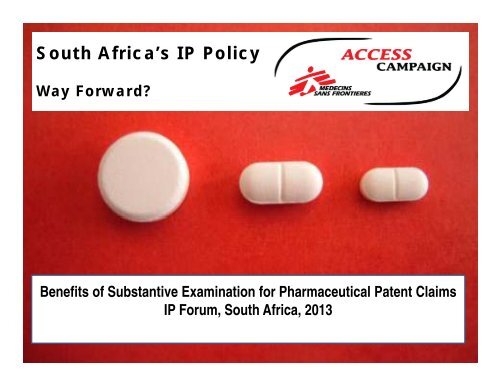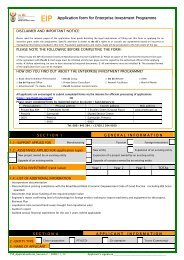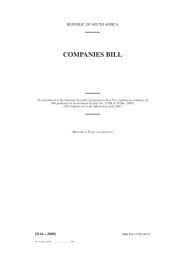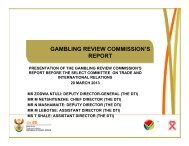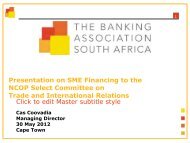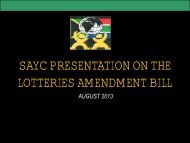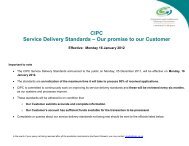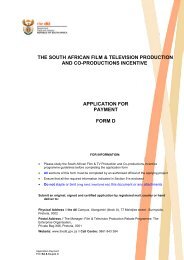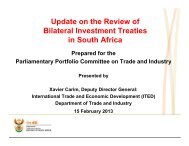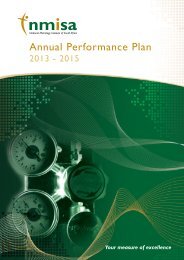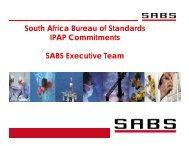Benefits of Substantive Examination for Pharmaceutical Patent Claims
Benefits of Substantive Examination for Pharmaceutical Patent Claims
Benefits of Substantive Examination for Pharmaceutical Patent Claims
Create successful ePaper yourself
Turn your PDF publications into a flip-book with our unique Google optimized e-Paper software.
South Africa’s IP Policy<br />
Way Forward?<br />
<strong>Benefits</strong> <strong>of</strong> <strong>Substantive</strong> <strong>Examination</strong> <strong>for</strong> <strong>Pharmaceutical</strong> <strong>Patent</strong> <strong>Claims</strong><br />
IP Forum, South Africa, 2013
Doctors Without Borders/ Medecins Sans Frontieres<br />
• MSF, is an independent international medical humanitarian organisation<br />
that delivers emergency aid to people affected by armed<br />
conflict, epidemics, natural or man-made disasters, or exclusion from<br />
health care in more than 70 countries.<br />
• MSF’s Access Campaign continues to work both on improving access<br />
to existing treatments and stimulating R&D <strong>for</strong> the development <strong>of</strong> new<br />
drugs and diagnostics that take into account the needs <strong>of</strong> people in poor<br />
countries.
Local <strong>Patent</strong>s linked to Local Prices<br />
<strong>Patent</strong><br />
No patent<br />
One supplier<br />
Multiple producers<br />
No competition<br />
Competition<br />
High prices <strong>of</strong><br />
imported medicines<br />
Access to low cost<br />
generic medicines
Generic competition needed to drive prices<br />
down: the example <strong>of</strong> AIDS medicines
Vital Importance <strong>of</strong> Generic Competition<br />
• Historical i treatment scale up on HIV/AIDS treatment since 2000 ‐ Td Today, more<br />
than 8 million people in developing countries receive antiretroviral therapy (ART)<br />
• Treatment scale‐up has been possible because <strong>of</strong> huge price drops due to<br />
generic competition<br />
• Ministries <strong>of</strong> Health and NGOs rely heavily on generic drugs as a critical<br />
component <strong>of</strong> sustainable treatment programs:<br />
• US ‐ 98% <strong>of</strong> PEPFAR’s ARV are generic, up from 15% in 2005 ‐ Generics saved<br />
PEPFAR $380 million in 2010 alone<br />
MSF’s Use <strong>of</strong> Generic Medicines<br />
• Most <strong>of</strong> the AIDS drugs that MSF<br />
uses worldwide are generics<br />
• MSF routinely also relies on<br />
generic versions <strong>of</strong> essential<br />
medicines to treat<br />
TB, malaria, and a wide range <strong>of</strong><br />
diseases
South Africa <strong>Patent</strong> system - Brief history<br />
Post independence high prices <strong>of</strong> medicines as lack <strong>of</strong><br />
safeguards in national patent law<br />
Monopoly: Thousands <strong>of</strong> product patents to MNCs has<br />
meant that local manufacturing has never really taken <strong>of</strong>f<br />
Know How: Limited capacity to manufacture<br />
•<br />
Unaf<strong>for</strong>dable: Some <strong>of</strong> the highest prices in the world
SOUTH AFRICA<br />
– TRIPS FLEXIBILITIES?<br />
WHAT THIS MEANS:<br />
No challenges to weak or<br />
invalid patent claims by third<br />
parties until after they have<br />
been granted.<br />
Pre‐Grant<br />
Opposition<br />
<strong>Patent</strong> Office
1987: first ARV AZT<br />
1996: TRIPLE HAART THERAPY<br />
2000:<br />
Glaxo Blocks Access To Lamivudine/Zidovudine<br />
in Ghana<br />
In ltt letters to a drug distributor ib t in Ghana and an<br />
Indian generic‐drug maker, Glaxo said sales <strong>of</strong><br />
generic versions <strong>of</strong> its drug, Combivir, in Ghana would be illegal<br />
because they would be violating company patents. As a result, the<br />
Indian company, Cipla Ltd. <strong>of</strong> Bombay, has stopped selling its<br />
low‐cost version in Ghana, a small country in West Africa.
AIDS drug access blocked by<br />
‘New Use’ patent on zidovudine
New use patent claims in South Africa<br />
Cancer drug<br />
Imatinib Mesylate <strong>Patent</strong>s: Evergreening Trend<br />
1993 + 20<br />
(2013)<br />
1997 + 20<br />
(2017)<br />
2002 + 20<br />
(2022)<br />
Imanitib<br />
compound and all<br />
its salts patented.<br />
(This patent<br />
expires in SA this<br />
year)<br />
New Use <strong>of</strong> Imatinib<br />
Mesylate salt <strong>of</strong><br />
<strong>Patent</strong>ed<br />
imatinib<br />
patented Granted in S.<br />
Africa
A number <strong>of</strong> countries have already set stricter standards <strong>of</strong><br />
patentability.<br />
‣ Peru, Bolivia, Columbia and Ecuador already exclude new use patents.<br />
India and Brazil exclude new use and new <strong>for</strong>mulation patents.<br />
Impact on medicine prices:<br />
Imatinib ib( (cancer)<br />
costs R867 per<br />
tablet in South<br />
Africa where it is<br />
patented, but only<br />
R86 in India where<br />
the patent was<br />
rejected because<br />
it is a new<br />
<strong>for</strong>mulation <strong>of</strong> an<br />
old medicine.<br />
Linezolid (TB) cost R264<br />
per tablet in the public<br />
sector and R676 per<br />
tablet in the private<br />
sector. The product<br />
patent t is set to expire e in<br />
2014 but an additional<br />
patent on the crystal<br />
<strong>for</strong>m <strong>of</strong> the medicine<br />
was granted in 2002. It<br />
is not clear if this will<br />
block generic entry after<br />
2014, until 2022. In<br />
India, generic versions<br />
are already available <strong>for</strong><br />
as little as R9.
Globalisation <strong>of</strong> <strong>Patent</strong> Rules<br />
• 1995 WTO Trade related aspects <strong>of</strong> intellectual<br />
property rights agreement (TRIPS)<br />
• “minimum” standards <strong>of</strong> protection <strong>of</strong> intellectual<br />
property rights<br />
• 20 year patents on pharmaceutical products<br />
• No differentiation between lifesaving medicines and<br />
trivial goods<br />
• 2005 Indian amended its patents act to be<br />
compliant with TRIPS and starts to grant product<br />
patents (transition period ends).
<strong>Patent</strong> Filing Trends in India<br />
• Major Increase in the number<br />
<strong>of</strong> patent applications filed at<br />
the Indian <strong>Patent</strong> Office (IPO)<br />
• PCT is the favorite filing route<br />
–~60% applications filed with<br />
the IPO were national phase<br />
filings under PCT<br />
• Majority <strong>of</strong> filers are <strong>for</strong>eign<br />
residents (Bayer, Gilead)<br />
<strong>Patent</strong> Filings at the IPO<br />
40000<br />
35000<br />
30000<br />
25000<br />
20000<br />
15000<br />
10000<br />
Source: Annual Reports <strong>of</strong> the IPO<br />
5000<br />
0<br />
No. <strong>Patent</strong>s Filed<br />
Source: Annual Reports <strong>of</strong> the IPO
2005: India parliament inserts safeguards against<br />
patent abuse<br />
Local <strong>Examination</strong> <strong>of</strong> patent applications by patent <strong>of</strong>fice<br />
Pre grant/post grant opposition <strong>of</strong> patent applications and invalid<br />
patents<br />
<strong>Patent</strong>ability criteria > What is not patentable: new use <strong>of</strong> an old<br />
drug, or simply derivatives <strong>of</strong> old drugs or combinations <strong>of</strong> old<br />
drugs (companies have to prove enhanced therapeutic efficacy)<br />
Compulsory license (license to generic companies to produce &<br />
market) and automatic licensing <strong>for</strong> drugs already in production<br />
Government use (public non-commercial use)<br />
Bolar exception (preparation <strong>for</strong> generic launch i.e. production <strong>for</strong><br />
marketing approval & marketing approval)<br />
Parallel importation
Developing countries & TRIPS<br />
‣ Reserve IP incentive <strong>for</strong> new compounds i.e. active<br />
ingredients that represent a fresh contribution to the<br />
stock <strong>of</strong> products available <strong>for</strong> medicinal use<br />
‣ But not all patent applications relate to new<br />
compounds. Majority are <strong>for</strong> existing drugs (new<br />
use, new <strong>for</strong>ms and new <strong>for</strong>mulations)<br />
‣ These can be rejected as such inventions that are<br />
common knowledge and practice in the<br />
pharmaceutical field
Novartis patent application on life saving cancer<br />
drug –CPAA files opposition in 2005<br />
l ’ l h b d<br />
Glivec’spatent 1993 application on the base compound was<br />
not eligible <strong>for</strong> an Indian filing because India joined the<br />
WTO only in 1995.
India<br />
High prices <strong>of</strong> patented drugs<br />
in TRIPS regime (post 2005)<br />
Raltegravir:<br />
<strong>Patent</strong>ed HIV drug used by<br />
MSF in its Mumbai clinic to<br />
treat patients who develop<br />
resistance costs about 1800<br />
USD per person per year<br />
First patent<br />
2002 ‐2022<br />
2nd patent application in<br />
2007 (+ 5 yrs if granted)<br />
Compound patent 212400<br />
Potassium Salt application<br />
4187/DELNP/2007<br />
(<strong>Patent</strong> opposition filed)
INDIA EXAMINATION SYSTEM<br />
COST EFFECTIVE SYSTEM<br />
One time costs: the Government <strong>of</strong> India embarked upon a plan to modernize and<br />
strengthen the intellectual property p (IP) <strong>of</strong>fices in the country as part <strong>of</strong> the ninth five-year<br />
plan (1997-2002), during which 2.5 million USD/22 million ZAR was spent on the<br />
development <strong>of</strong> the infrastructure <strong>of</strong> IP <strong>of</strong>fices.<br />
During the eleventh five year plan (2007-12), the Government earmarked addition 56<br />
million USD (485 million ZAR) <strong>for</strong> human resource development.<br />
During 2009-2010, the Indian patent <strong>of</strong>fice generated revenue <strong>of</strong> Rs. 142.62 crore (230<br />
million ZAR) while its expenditure (including design administration) amounted to Rs. 21.87<br />
Crores (35 million ZAR). There<strong>for</strong>e, the revenue surplus during this period amounted to Rs.<br />
120.75 Crores (195 million ZAR).<br />
The revenue is generated through collection <strong>of</strong> fees on various activities related to<br />
filing <strong>of</strong> applications, their examination and the maintenance <strong>of</strong> patents that are<br />
awarded
200<br />
150<br />
Indian <strong>Patent</strong> Office<br />
130.24<br />
156.15<br />
142.62<br />
100<br />
93.64<br />
106.34<br />
50<br />
0<br />
18.54 21.87<br />
15.84<br />
5.78 9.87<br />
2005-2006 2006-2007 2007-2008 2008-2009 2009-2010<br />
Revenue (in Cr)<br />
Non-Plan Expenditure(in Cr)<br />
The expenditure provided in the budget <strong>for</strong> routine activities <strong>of</strong> the<br />
government are called non‐plan expenditure. Its examples are expenditure<br />
incurred on administrative i i services, salaries and pension etc.
EXAMINATION SYSTEM<br />
• IT enabled to ensure a transparent IP system<br />
• 337 sanctioned posts <strong>of</strong> Examiners and 94 posts <strong>of</strong><br />
Controllers <strong>of</strong> <strong>Patent</strong>s and Designs<br />
• Master’s degree in Physics/Chemistry/Bio-Chemistry/Micro<br />
Biology/Bio-Technology ogy/ o o ogy or a degree ee in<br />
Engineering/Technology<br />
• Institutional training <strong>for</strong> examiners.<br />
(Has led to employment generation)
“ p]olicy makers in the health area, as well as patent<br />
examiners, should be aware that decisions relating to<br />
the grant <strong>of</strong> a patent…can directly affect the health<br />
and lives <strong>of</strong> the people <strong>of</strong> the country where the patent<br />
is granted and en<strong>for</strong>ced.” –<br />
WHO/UNCTAD ‘Guidelines <strong>for</strong> the<br />
examination <strong>of</strong> pharmaceutical patents:<br />
Developing a public health perspective.’ p
Compulsory licensing<br />
Indian <strong>Patent</strong> tAct<br />
Specific Provisions:<br />
Sec. 84 – On application by generic companies<br />
Sec. 92 – notification by central govt <strong>for</strong> public<br />
noncommercial<br />
use/national emergency/extreme<br />
urgency<br />
Sec. 92A – <strong>for</strong> export<br />
Sec. 100 – govt use
First CL in India<br />
Cancer Drug-Sorafenib Tosylate 200 mg<br />
300,000<br />
Rs. 2,80,428<br />
250,000<br />
Natco Pharma requested <strong>for</strong> a<br />
CL <strong>for</strong> the anti‐cancer drug<br />
Nexavar (Sorafenib Tosylate),<br />
patented by Bayer<br />
Rs./pe er patient per ye ear<br />
200,000<br />
150,000<br />
100,000<br />
50,000<br />
Originator Company<br />
Generic Companies<br />
8,880 6,840<br />
0<br />
Bayer<br />
Natco<br />
Pharma<br />
* The graph highlights the generic price <strong>of</strong> the cancer drug sorafenib<br />
tosylate. The drug is patented in India and Bayer's price is<br />
unaf<strong>for</strong>dable. Natco has applied <strong>for</strong> a compulsory license to the<br />
Indian patent <strong>of</strong>fice in July 2011 and has committed to substantially<br />
reduce the prices by 97%(31 times) <strong>for</strong> cancer patients in India who<br />
need the drug if the compulsory license to produce the generic<br />
version is granted to the company by the Indian patent <strong>of</strong>fice.<br />
Not <strong>for</strong> drug supplied to the<br />
Public sector but actually sold in<br />
The private sector<br />
Granted in March 2012:<br />
o Bayer’s import was grossly<br />
inadequate to the needs (hardly<br />
2%)<br />
o No import in certain years<br />
o Price not reasonably af<strong>for</strong>dable to<br />
the public. Bayer price 5210 USD<br />
<strong>for</strong> 120 tabs <strong>for</strong> a month; Natco<br />
164 USD
No R&D <strong>for</strong> ‘poor’ markets<br />
“Keeping the cold chain to conserve the vaccines at<br />
the right temperature, when it’s 45 degrees Celsius<br />
outside is a major challenge. You can imagine how<br />
many icepacks are needed, so even getting the<br />
vaccines out to the villages is a huge logistical<br />
ef<strong>for</strong>t in itself. ”<br />
Dr. Michel Quéré, MSF Medical Advisor <strong>for</strong><br />
programmes in Niger, Chad and DRC<br />
“A number <strong>of</strong> previously<br />
treatable diseases - including<br />
major childhood killers in Africa<br />
- are becoming far more<br />
difficult and expensive to treat<br />
because <strong>of</strong> antibiotic<br />
resistance. In practice, this<br />
may mean that many <strong>of</strong><br />
these diseases may not be<br />
treated at all. ”<br />
Nathan Ford, Medical<br />
Coordinator, MSF Access<br />
Campaign<br />
“One important antiretroviral<br />
drug <strong>for</strong> children is<br />
lopinavir/ritonavir. It exists as<br />
syrup which has to be stored at<br />
a temperature between two and<br />
eight degrees until the moment<br />
it is dispensed. The syrup tastes<br />
terrible to children and contains<br />
more than 40 per cent alcohol,<br />
so it really is not optimal to be<br />
<strong>of</strong>fering this to a young child.<br />
We urgently need another<br />
solution. ”<br />
Dr. Marianne Gale, MSF Medical<br />
Advisor <strong>for</strong> paediatric<br />
tuberculosis & HIV


